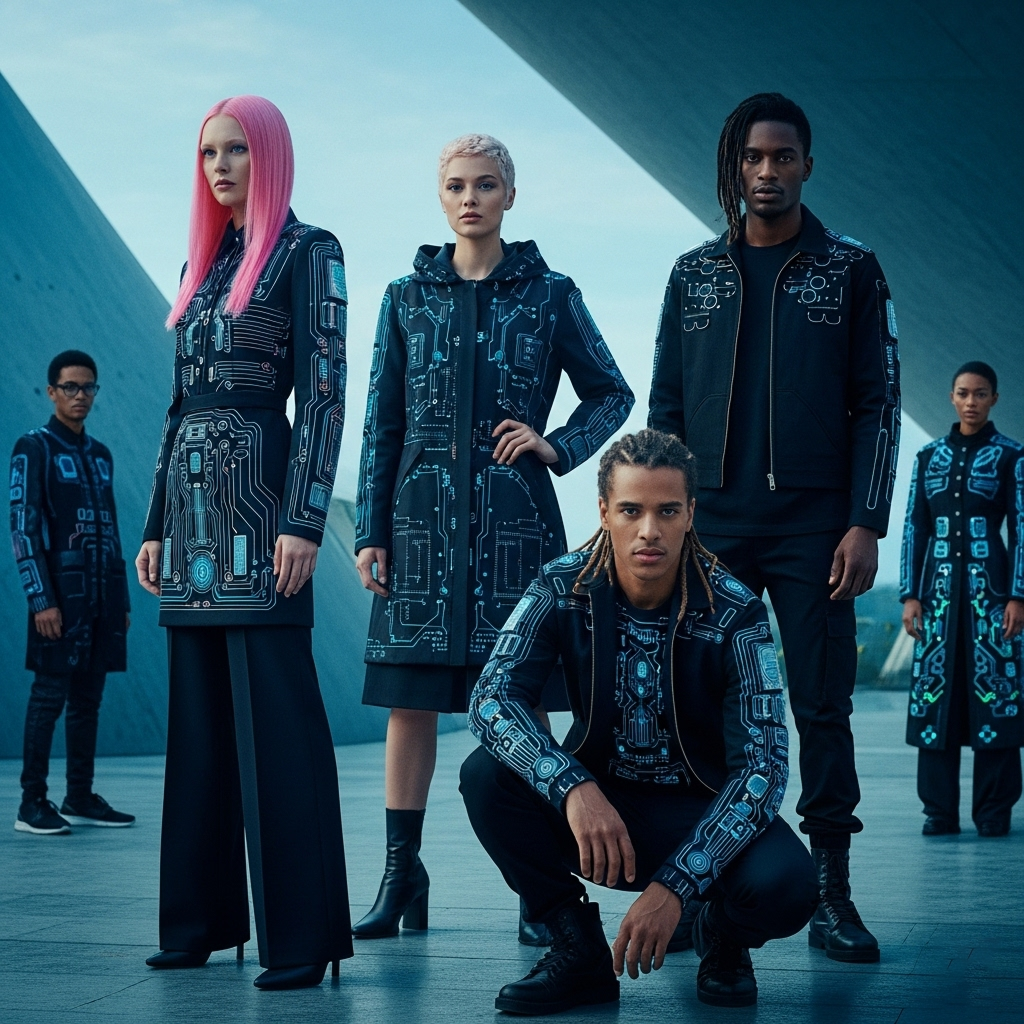Blog
Fashion and Technology: Innovation at the Intersection of Style and Science

For centuries, the fashion industry was largely driven by craftsmanship, artistic vision, and traditional manufacturing methods. Trends emerged from design houses, filtered through magazines, and then slowly made their way to consumers. However, in the 21st century, a powerful new force has emerged: technology. Far from being a separate entity, technology is now deeply intertwined with every facet of fashion, from the very fibers of our clothing to the way we discover, purchase, and even interact with garments. This fusion of style and science is not just optimizing existing processes; it’s ushering in a new era of innovation, sustainability, and personalization that is fundamentally reshaping the industry.
Smart Textiles and Wearables: Clothes That Do More
One of the most visible intersections of fashion and technology is in the realm of smart textiles and wearables. These aren’t just gadgets you wear; they are fabrics and garments with integrated digital components, designed to enhance functionality and interact with the user or their environment.
Integrated Electronics: Imagine a jacket that heats up in cold weather, sportswear that monitors your vital signs, or a t-shirt that can detect UV radiation. Companies are embedding sensors, conductive threads, and micro-batteries directly into fabrics to create clothing that is responsive and intelligent.
Performance Wear: Athletes have long benefited from advanced material science in their gear, but this is expanding rapidly. Fabrics that wick moisture more effectively, regulate temperature, or offer superior compression are constantly being developed. Some are even self-cleaning or odor-resistant, reducing the need for frequent washing and prolonging garment life.
Fashionable Wearables: Beyond pure functionality, designers are increasingly integrating wearable tech like smartwatches, fitness trackers, and augmented reality glasses seamlessly into fashionable accessories, blurring the lines between tech device and stylish statement piece. The goal is to make technology disappear into beautiful design.
3D Printing and Digital Design: From Concept to Customization
The design and manufacturing stages of fashion are being revolutionized by digital advancements, particularly 3D printing and advanced design software.
Rapid Prototyping and Sample Creation: Instead of laboriously crafting multiple physical samples, designers can now create virtual prototypes using 3D design software (like CLO 3D or Optitex). This dramatically reduces waste, saves time, and cuts costs associated with physical sampling.
Customization and On-Demand Manufacturing: 3D printing allows for incredible precision and the creation of complex geometries that are difficult or impossible with traditional methods. This opens up possibilities for highly customized garments, footwear, and accessories tailored to individual body scans. It also facilitates on-demand manufacturing, where items are only produced once an order is placed, significantly reducing overproduction and textile waste.
Innovative Materials: Beyond plastics, 3D printing is experimenting with diverse materials like liquid resins, bio-based filaments, and even recycled materials to create unique textures and structures for fashion.
Artificial Intelligence (AI) and Big Data: The Brains Behind the Trends
AI is rapidly becoming the silent engine driving efficiency, personalization, and strategic decision-making in the fashion industry.
Trend Forecasting: AI algorithms can analyze vast datasets, including social media trends, sales figures, economic indicators, and even political shifts, to predict upcoming fashion trends with astonishing accuracy. This allows brands to be more agile and responsive to consumer demand.
Personalized Recommendations and Styling: E-commerce platforms use AI to analyze individual Browse and purchase history, offering highly personalized product recommendations and even virtual styling advice, enhancing the customer experience.
Supply Chain Optimization: AI can optimize inventory management, predict demand fluctuations, and streamline logistics, reducing waste from overstocking and ensuring products reach consumers efficiently.
AI-Generated Designs: While still in nascent stages, AI is being explored for its potential to assist in the creative process, generating design concepts or variations based on input parameters, offering a new tool for designers.
Augmented Reality (AR) and Virtual Reality (VR): Immersive Experiences
AR and VR are transforming how consumers interact with fashion, bridging the gap between the physical and digital worlds.
Virtual Try-On Experiences: Online shoppers can now use AR apps on their smartphones to “try on” clothes virtually, seeing how garments fit and look on their own bodies before making a purchase. This has the potential to significantly reduce online returns.
Immersive Fashion Shows and Virtual Stores: Brands are experimenting with VR to create immersive virtual fashion shows, allowing audiences from anywhere in the world to experience the runway as if they were there. Some brands are also developing virtual stores in the metaverse, offering a new dimension for shopping and brand interaction.
Digital Fashion and NFTs: The rise of the metaverse has given birth to digital fashion – clothing designed purely for avatars in virtual worlds. These digital garments can be purchased, worn, and even sold as NFTs (Non-Fungible Tokens), creating a new economy around virtual apparel. This represents a complete decoupling of fashion from physical materiality.
Robotics and Automation: Efficiency in Production
While often associated with sci-fi, robotics are increasingly being integrated into fashion manufacturing to improve efficiency and consistency.
Automated Cutting and Sewing: Robots are capable of precise cutting of fabrics, and advanced robotics are beginning to tackle the complex task of sewing, particularly for simpler garments. This can speed up production and reduce labor costs.
Warehouse Automation: Automated systems in warehouses streamline inventory management, order picking, and packaging, ensuring faster fulfillment of online orders.
Micro-Factories: The ability to automate parts of the production process is enabling the creation of smaller, localized “micro-factories” that can produce garments closer to consumers, reducing shipping times and environmental impact.
Sustainability Through Technology: A Greener Future
Perhaps one of the most promising aspects of technology in fashion is its potential to drive sustainability.
Reduced Waste: 3D printing and on-demand manufacturing minimize textile waste from overproduction. Digital design reduces the need for physical samples.
Efficient Resource Use: Technologies like waterless dyeing, AI-optimized cutting (to reduce fabric scraps), and advanced recycling processes for textiles significantly reduce the industry’s environmental footprint.
Supply Chain Transparency: Blockchain technology can create an immutable, transparent record of every step in a garment’s supply chain, allowing consumers to verify ethical and sustainable practices.
New Eco-Materials: Biotechnology is enabling the creation of entirely new, sustainable materials like lab-grown leather, mushroom-based fabrics, and fibers from algae or agricultural waste.
Challenges and Ethical Considerations
Despite the immense opportunities, the integration of technology in fashion also presents challenges:
Data Privacy: The collection of vast amounts of consumer data for personalization raises concerns about privacy and data security.
Job Displacement: Automation and AI could lead to job losses in traditional manufacturing roles, requiring new training and adaptation for the workforce.
Accessibility: Ensuring that these advanced technologies are accessible to smaller brands and not just large corporations is crucial for fostering innovation across the industry.
Digital Divide: Not everyone has access to the latest tech or high-speed internet, which could create disparities in who can experience cutting-edge fashion interactions.
Conclusion: The Phygital Frontier
The future of fashion is undeniably phygital – a seamless blend of the physical and digital. Technology is no longer merely a tool; it’s a co-creator, enabling designers to push creative boundaries, streamlining production, fostering greater transparency, and delivering highly personalized experiences to consumers. From clothes that monitor our health to virtual garments we wear in the metaverse, the intersection of style and science is opening up exciting new frontiers. As the fashion industry continues to embrace these innovations, it promises a future that is not only more efficient and sustainable but also endlessly imaginative and tailored to the unique desires of every individual.
